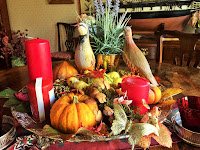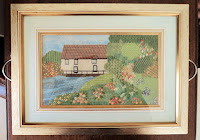Flowers in Needlework / Burn Incident
I know no-one who doesn’t love flowers, the colours the
smell so little wonder, flowers have been a favourite subject with artists and
embroiderers throughout the ages.
In Victorian times, with the increased leisure time among the middle classes, embroidery and watercolour painting were practiced and flowers particularly popular. Berlin wool work designs printed, hand coloured in the early days were worked with a special wool and sometimes beads –illustration.
 This design is featured in my book ‘Traditional Needle Arts
Needlepoint, has a full chart of th design and is called ‘Country Bouquet’
This design is featured in my book ‘Traditional Needle Arts
Needlepoint, has a full chart of th design and is called ‘Country Bouquet’
 Do take a look at my web particularly the Patchwork with
Iris (this can be ordered with other flowers) and the Elderflower and Lilac
designs, both worked with Shadow stitching – offered with a special Manual, the
option of two borders and stitches fully diagrammed. Each if these designs introduce a whole range
of stitches that allow the painted canvas to be part of the design.
Do take a look at my web particularly the Patchwork with
Iris (this can be ordered with other flowers) and the Elderflower and Lilac
designs, both worked with Shadow stitching – offered with a special Manual, the
option of two borders and stitches fully diagrammed. Each if these designs introduce a whole range
of stitches that allow the painted canvas to be part of the design.
 I both love and need the magnification and the inbuilt light
that goes with it – in fact I have two types, the first that benefits from an
extra large lens (I can see my whole design without moving It around) and the
second that can either stand, clip on a table and uses either electricity or
batteries. The first I keep in the
studio fixed permanently and travel with the other.
I both love and need the magnification and the inbuilt light
that goes with it – in fact I have two types, the first that benefits from an
extra large lens (I can see my whole design without moving It around) and the
second that can either stand, clip on a table and uses either electricity or
batteries. The first I keep in the
studio fixed permanently and travel with the other.
 Horror, horror today I found a burn hole on my current Lilac
design – I truly didn’t think the sun had been that strong but I had been
proved wrong. Thankfully as you can see the hole was on the edge of the canvas, nowhere near the stitching but what
might have happened?
Horror, horror today I found a burn hole on my current Lilac
design – I truly didn’t think the sun had been that strong but I had been
proved wrong. Thankfully as you can see the hole was on the edge of the canvas, nowhere near the stitching but what
might have happened?
 |
| My own Boots. Purchased in Turkey. |
In Elizabethan times, the English, well known for their love
of gardening, have used flowers often in a naturalistic style than most other
countries – vegetables and fruit were
almost as popular. The larger pieces
were often planned and sometimes worked by professional men but these too
frequently hade flowers and foliage as part of the design.
My favourite reference books
The Needleworker’s Dictionary’ - Pamela Clabburn
‘The Embroiderer’s Flowers – Thomasina Beck.In Victorian times, with the increased leisure time among the middle classes, embroidery and watercolour painting were practiced and flowers particularly popular. Berlin wool work designs printed, hand coloured in the early days were worked with a special wool and sometimes beads –illustration.
The example here is from my own collection, the design
worked entirely with glass beads on a perforated paper with an embossed
border. The unusual frame was how I
found it and is probably the original.
 This design is featured in my book ‘Traditional Needle Arts
Needlepoint, has a full chart of th design and is called ‘Country Bouquet’
This design is featured in my book ‘Traditional Needle Arts
Needlepoint, has a full chart of th design and is called ‘Country Bouquet’
William Morris around the turn of the 19/20 century designed
wallpapers, fabrics and embroideries many designs featuring flowers, foliage
and birds.
While I am possibly best known for geometric designs using
interesting textured stitches there has always been hand-painted flowers for
cushions, upholstery and rugs.
One of my favourite designs is Flower Shop
 Do take a look at my web particularly the Patchwork with
Iris (this can be ordered with other flowers) and the Elderflower and Lilac
designs, both worked with Shadow stitching – offered with a special Manual, the
option of two borders and stitches fully diagrammed. Each if these designs introduce a whole range
of stitches that allow the painted canvas to be part of the design.
Do take a look at my web particularly the Patchwork with
Iris (this can be ordered with other flowers) and the Elderflower and Lilac
designs, both worked with Shadow stitching – offered with a special Manual, the
option of two borders and stitches fully diagrammed. Each if these designs introduce a whole range
of stitches that allow the painted canvas to be part of the design.
I do hope this walk through our English tradition of
enjoying flowers has encouraged you to consider your next project to be
flowers, I should love to help you.
Don’t cause a fire and burn the house down! (Part 2 of Blog)
One has always been told to be extremely careful with any
form of magnification, to always cover the lens over even if left for only a
short time.
 I both love and need the magnification and the inbuilt light
that goes with it – in fact I have two types, the first that benefits from an
extra large lens (I can see my whole design without moving It around) and the
second that can either stand, clip on a table and uses either electricity or
batteries. The first I keep in the
studio fixed permanently and travel with the other.
I both love and need the magnification and the inbuilt light
that goes with it – in fact I have two types, the first that benefits from an
extra large lens (I can see my whole design without moving It around) and the
second that can either stand, clip on a table and uses either electricity or
batteries. The first I keep in the
studio fixed permanently and travel with the other.
Most fittings of this kind are sold with some form of lens
cover, a dish or small bag but I confess if they did arrive with a suitable
cover I have mislaid them! Instead I
cover them with a pillow case – if I was clever with a sharp needle or sewing
machine I would make a cotton draw string bag.
 Horror, horror today I found a burn hole on my current Lilac
design – I truly didn’t think the sun had been that strong but I had been
proved wrong. Thankfully as you can see the hole was on the edge of the canvas, nowhere near the stitching but what
might have happened?
Horror, horror today I found a burn hole on my current Lilac
design – I truly didn’t think the sun had been that strong but I had been
proved wrong. Thankfully as you can see the hole was on the edge of the canvas, nowhere near the stitching but what
might have happened?
Please do learn from my almost disaster – one hears of whole
houses being burnt down – and never never leave any magnification uncovered.
If you would like details of the two fittings I find so
good, do let me know.



Comments
Post a Comment